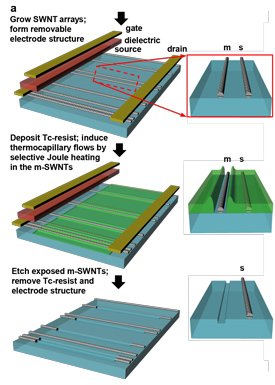McCormick Researchers Develop Separation Technique for Carbon Nanotubes
Important advance published in journal Nature Nanotechnology
As electronics approach the inevitable post-silicon era — the point at which no more silicon-based transistors can be squeezed onto a microchip — many researchers have their eye on carbon nanotubes.
These tiny carbon tubes have been touted for their exceptional electrical properties, but when carbon nanotubes are synthesized, two types of nanotubes — conducting and semiconducting — are tangled together in an inseparable mass. For optimal electronics, researchers must be able to harvest them separately, creating aligned, horizontal arrays of purely semiconducting carbon nanotubes.
 Northwestern University researchers, working with an international team, have developed a method to achieve this. A paper describing the research, “Using Nanoscale Thermocapillary Flows to Create Arrays of Purely Semiconducting Single-walled Carbon Nanotubes,” was published April 28 in the journal Nature Nanotechnology.
Northwestern University researchers, working with an international team, have developed a method to achieve this. A paper describing the research, “Using Nanoscale Thermocapillary Flows to Create Arrays of Purely Semiconducting Single-walled Carbon Nanotubes,” was published April 28 in the journal Nature Nanotechnology.
The researchers began with carbon nanotubes grown on the surface of quartz crystal, with conducting and semiconducting nanotubes randomly mixed. (Carbon nanotubes are either conducting or semiconducting based on their chirality, the angle that describes the arrangement of carbon atoms along the length of the nanotube.)
The researchers submerged all the nanotubes in a layer of organic coating, then sent an electric current through them. The current passed through and heated the conducting nanotubes, causing the organic coating above them to melt and flow toward the regions with cooler temperatures.
The trenches formed by the heat-avoidant organic coatings exposed the conducting nanotubes, which the researchers then chemically removed. A second chemical etching process removed the organic coatings, leaving behind just the semiconducting carbon nanotubes.
“The electrical properties of the resulting pure, semiconducting carbon nanotubes is more than 1,000 times better than the electrical properties of mixed carbon nanotubes,” said Yonggang Huang, Joseph Cummings Professor of Civil and Environmental Engineering and Mechanical Engineering at Northwestern’s McCormick School of Engineering and Applied Science.
 “This method is extremely effective in producing semiconducting carbon nanotubes for future electronic devices not based on silicon — with properties much better than silicon,” Huang added.
“This method is extremely effective in producing semiconducting carbon nanotubes for future electronic devices not based on silicon — with properties much better than silicon,” Huang added.
The semiconducting carbon nanotubes could be integrated with metal to create next-generation electronic devices, or a similar process could be devised to harvest purely conducting carbon nanotubes to replace the metal.
The research was conducted in collaboration with John A. Rogers, Swanlund Chair Professor at the University of Illinois at Urbana-Champaign.
Other partners include lead co-authors Sung Hun Jin and Simon N. Dunha, Xu Xie, Ji-hun Kim, Ahmad Islam, Frank Du, Monisha Menon, Eugene Cho, Kyle L. Grosse, Dong Joon Lee, Ha Uk Chung, Eric Pop, William P. King, Jaeseong Kim, Johnny Felts, and Feng Xiong, all of the University of Illinois at Urbana-Champaign; Jizhou Song of the University of Miami; Chaofeng Lu of Northwestern University and Zhejiang University in China; Yuhang Li of Northwestern University; and Muhammad A. Wahab and Muhammad A. Alam of Purdue University.